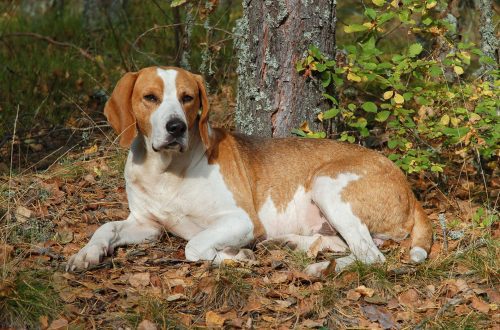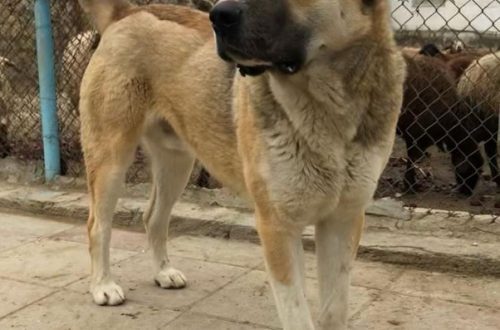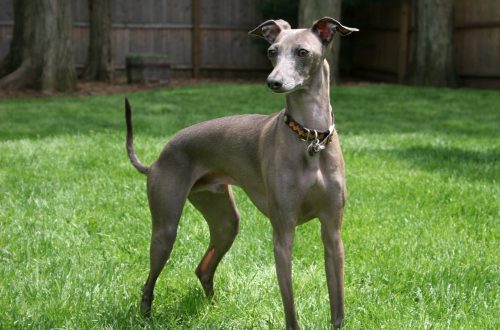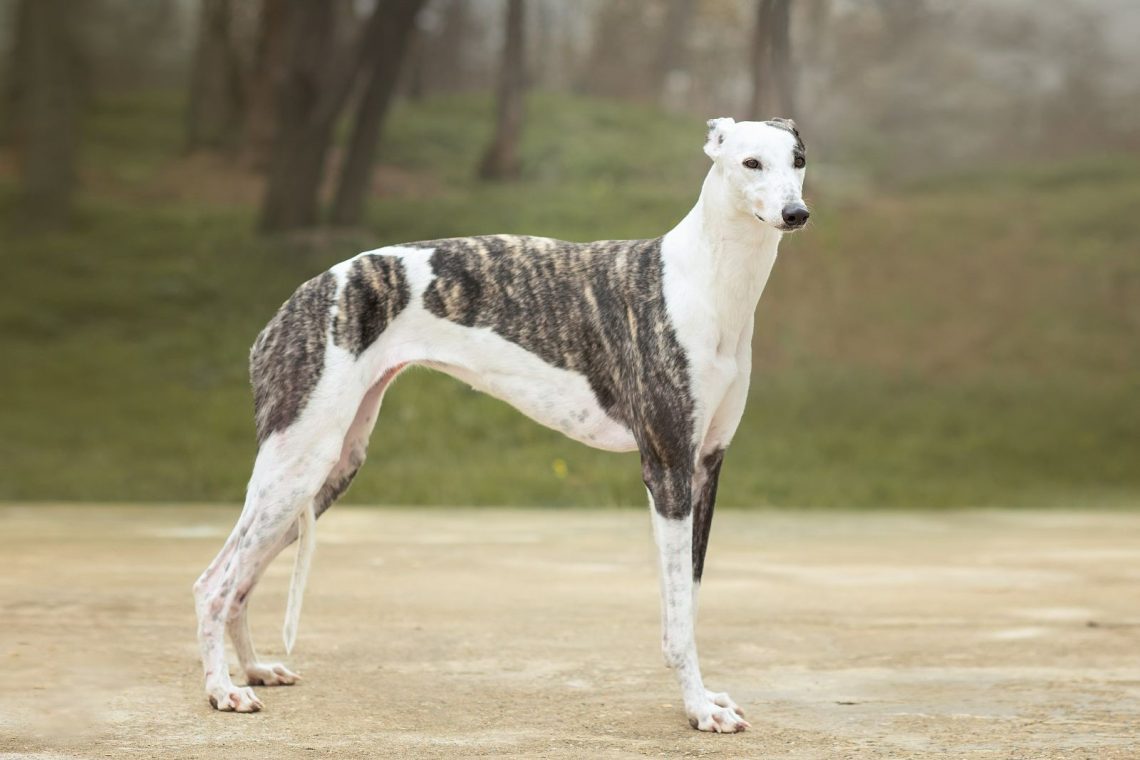
Greyhound
The Greyhound is the fastest breed in the world, the main “qualifications” of which are hunting for field game and running.
| Country of origin | Great Britain |
| The size | large |
| Growth | 62-72 cm |
| Weight | 24-35 kg |
| Age | about 16 years old |
| FCI breed group | greyhounds |
Contents
Basic moments
- In England, Greyhounds are called “fast couch potatoes” because of their calm temperament and fanatical love for relaxation on soft and not very mattresses.
- The literal translation of the breed’s name is “gray greyhound”, although modern linguists believe that “greyhound” is a distorted form of the Old English “grighound” – cricket greyhound. In favor of the latest version is the fact that animals have the same springy and long jump as crickets.
- Greyhounds hunt by relying primarily on sight, as their sense of smell is less acute.
- English greyhounds are sensitive to cold and damp. Thin, not reinforced with undercoat wool does not warm them in cold weather, and also poorly protects the skin from injury.
- These natives of Foggy Albion have an original hunting “handwriting”: they run up to the beast that has discovered itself with lightning speed, sharply attacking the prey, but they are not capable of long, exhausting chases.
- According to intellectual indicators, Greyhounds are ranked 46th in Stanley Coren’s list of the smartest breeds.
- Greyhound males mature more slowly than females, both physically and psychologically.
- In 1994, the Greyhound Star Title entered the Guinness Book of Records as the fastest dog in the world. His top speed on the run was 67.32 km/h.
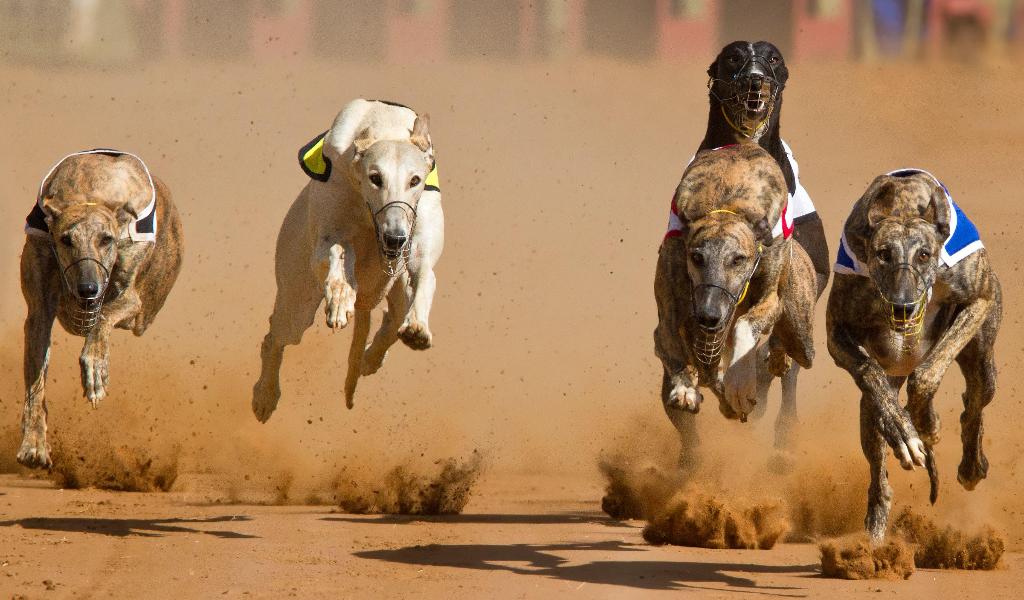
Greyhound is a star of circular tracks, a gambling hunter and a good-natured sleepyhead, madly in love with his owner. Maybe he is not the best campaigner who understands any requirements perfectly, but he is a wonderful friend and companion who knows how to show delicacy and patience where circumstances require it. True, Greyhounds settle down only to a conscious age, quite rightly believing that childhood is the best time to test the peace and patience of others.
History of the Greyhound breed
The past of Greyhounds is full of white spots and historical inaccuracies. For example, until the beginning of the 21st century, Ancient Egypt was considered their homeland. It was there that the first images of dogs similar to the Saluki were found, which arrived in the Nile Valley with the Bedouin tribes (according to another version, with the caravans of Alexander the Great). However, after a genetic analysis conducted in 2004, it turned out that Greyhounds are not related to Egyptian dogs, but they have much in common with shepherd dogs. This forced scientists to put forward a new hypothesis about the origin of the breed, according to which the ancient Celts brought the ancestors of the greyhounds with them.
By the 10th century AD, the failed relatives of the Saluki had become famous in Europe, and especially in Great Britain, where they were bred for gunless hunting. Swift and grippy, Greyhounds have proven themselves to be unsurpassed sprinters, able to get a hare or a roe deer in a matter of minutes. At the beginning of the 11th century, after the “Law on Forests” was issued, hunting for the lower classes, as well as keeping hunting dogs, were closed. This helped the breed step up a notch in terms of status, since now only European nobility was in charge of its breeding.
By the 18th century, the Greyhounds entered a period of decline and, if not for the efforts of the British breeder Lord Alford, the animals could have completely disappeared. It was under the patronage of an aristocrat that a hunting club was registered in 1776, in which the first field trials of greyhounds, including greyhounds, were conducted. In addition, Alford managed to put his own hand in updating the breed by mixing a bit of English bulldog blood into its genotype .
19th Sentury
Greyhounds made their debut at exhibitions only in the second half of the 19th century, with the growing popularity of such an event as dog racing. In the same period, the clan of English greyhounds broke up into three independent branches: exhibition, running and hunting. At the same time, the official recognition of the breed was delayed until 1946, that is, until the first British Greyhound Club was opened at the initiative of the AKC.
Greyhounds have been seen in Russian kennels since the 18th century, but due to their fabulous cost and elitist image, their numbers were small. After the October Revolution, the vast majority of individuals were completely exterminated, as a bourgeois relic, therefore, until the end of the 80s. In the 20th century, there was not a single purebred greyhound in the USSR. Only after the collapse of the Union, a stream of four-legged producers from the USA, Germany, Hungary and Czechoslovakia poured into the country, which laid the foundation for a tribe of domestic Greyhounds.
An interesting fact: Greyhound genes gave the world and saved many breeds from degeneration, including Deerhounds, Whippets, Irish Wolfhounds , Galgos, Magyar Agars and others.
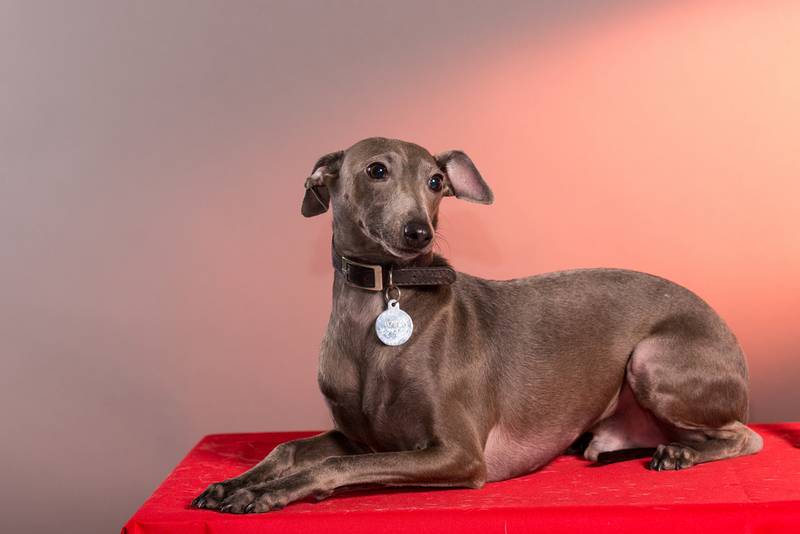
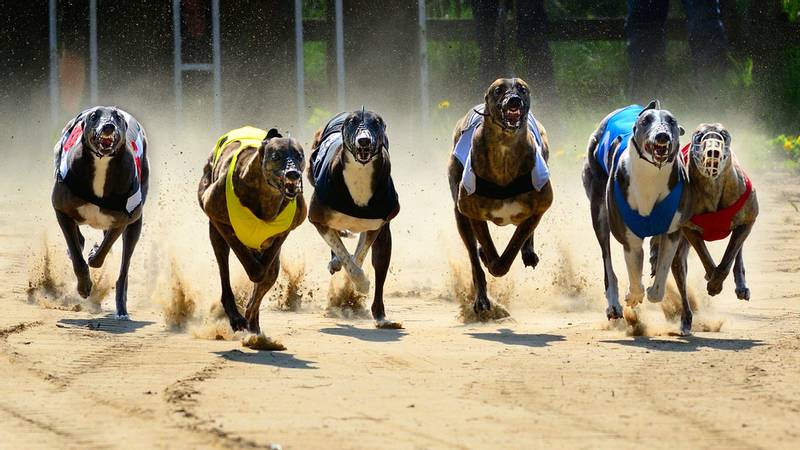
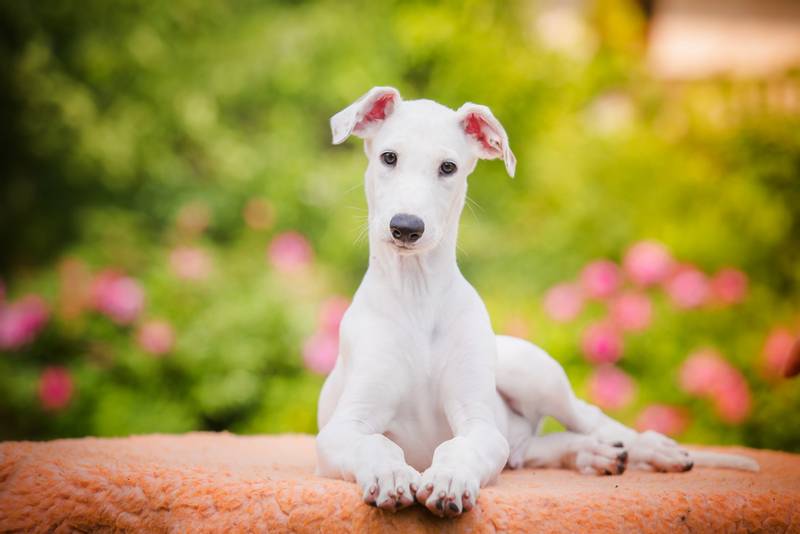
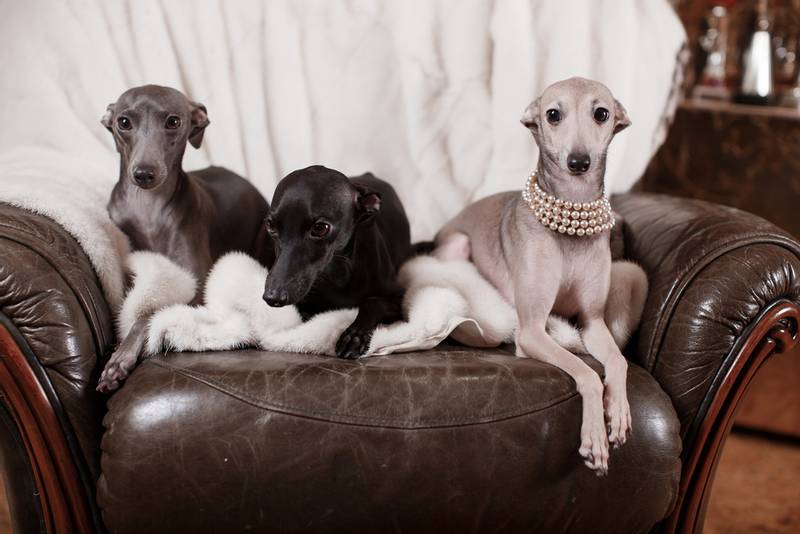
Greyhound breed standard
This sporty “Englishman” has very few specific breed features, so in the ring he is judged by the overall impression he made, without delving into the details of the exterior. If we turn to the standard, then the correct Greyhound should be distinguished by stateliness, combined with the elegance of the silhouette and the indispensable leggy. That is, on the one hand, it is a graceful, slender creature with a noble posture, and on the other, a serious working dog with developed muscles. The balance of the figure is an equally important selection criterion, therefore, breeding specialists reject both too tall individuals and short-legged “rolling” ones that have built up excess muscle mass. By the way, about the muscles: they are not voluminous in the Greyhound, but stretched in length, which makes his figure refined.
The growth of males should be in the range of 71-77 cm, females a little lower – 68-71 cm. The weight of adults is 29-32 kg and 27-29 kg, respectively.
As in the 19th century, today Greyhound breeding is carried out along three main lines.
- Show class – decorative handsome men with a glossy appearance, future ring stars, as well as potential “collectors” of diplomas and medals. Mandatory characteristics – high growth (for males – 76-77 cm), a beautiful bend of the neck, light, relaxed movements.
- The running branch is born athletes, devoted fans of coursing. Outwardly, dogs give the impression of lean and light creatures.
- The hunting type is an amateur variety. For such “boys” and “girls”, performance characteristics prevail over external virtues. These are low owners of wide backs and convex lower backs.
Representatives of different breed “qualifications” should not interbreed.
Head
Elongated, moderately wide, with a flat cranium. The muzzle is elongated, with a smooth transition. On show inspection, the Greyhound’s head is not the most highly valued body part. The main thing is that it looks textured and lean.
Jaws and teeth
The massive jaws of the Greyhound close into full-fledged “scissors” (the upper incisors overlap the outer side of the lower ones).
Eyes
The eyes of the Greyhound are oval, shiny, set slightly obliquely. Despite the fact that the judging committees prefer a dark shade of the iris, dogs with a weakened coat color are characterized by lighter eyes.
Ears
Neat, thin, reminiscent of a rose. Usually the ear cloth is laid back, but in a wary animal it assumes a semi-erect position.
Neck
The correct neck of the English greyhound is long, well muscled, with a soft transition to the withers, without skin folds and dewlaps. Unlike the head, a neck that does not fit into the standard can spoil the show karma for a Greyhound.
Frame
The body of the Greyhound looks quite stretched, even powerful. The chest is strong and deep, with markedly arched ribs and a relief undermining (transition from the sternum to the abdomen). The back is elongated, dense, with a massive loin.
limbs
The Greyhound’s shoulder blades are in an oblique position, distinguished by muscularity and general dryness of the contours. Forearms are straight and long. The elbows are set freely, under the shoulder blades, pasterns are small. Strong hips and shins of the dog indicate a powerful push. The hocks are wide and set low. The articulation angles of the knee are distinct. Paws of a hare type with strongly arched fingers and dense claws.
movements
Greyhound moves with a linear, sweeping stride, which allows him to build up his maximum speed in the first seconds of running. In the strength of the push, the hind limbs of the English Greyhound are inferior to the paws of trotting breeds, however, they move freely, without “cohesion”.
Tail
The Greyhound’s tail is its rudder in motion. In pedigree individuals, the tail is low-set, thick at the base, tapering as it moves away from the croup. Both standing and running, the tail is carried low, forming a slight bend from the middle (the crescent shape is already too much).
Wool
Smooth, close-lying and pleasant to the touch, Greyhound hair has a dense texture. The coat is thick on all parts of the body except for the belly and inner thighs. The undercoat is slight.
Color
Greyhounds can be red, black, blue, white, brindle, fawn, and can have a “diluted” suit: all of the listed colors in combination with white spots.
Disqualifying vices
Malformations of development and behavior, in the presence of which English greyhounds are not allowed to participate in exhibition events and breeding, are cryptorchidism, cowardice and unreasonable aggression towards humans.
Greyhound character
In the body of a Greyhound, two “dog-likenesses” coexist at once, one of which is a merciless hunter and athlete, and the second is an imposing indoor minion that occupies a couch for days. For example, if an interesting job does not loom on the horizon, the dog can enjoy hours on the rug, then plunging into the world of sweet dreams, then leaving it. As it should be for pack breeds, Greyhounds are very dependent on the team, and the dog considers both the family in which he lives and other greyhounds living in the house to be his own “pack”. In the second case, there will be a rigid hierarchy of the type: the leader is one, the rest are on vocals.
Greyhounds are not annoyed by children, but judgments about dogs as great nannies are still too much. Grays were never bred in order to “graze” the kids, however, they were not taught to hunt presumptuous undergrowth either. In general, animals are patient with children’s pranks, but in delicate situations they often prefer to retreat than to fight back. But Greyhounds adore their owners to unconsciousness. The puppies’ affection is especially pronounced: branded jumping and attempts to lick the “leader’s” face – an obligatory fad in the relationship between a young gray and a person.
Greyhounds peacefully coexist with other pets, but do not like generalizations. So, for example, a dog may seem completely indifferent to the cat living in your apartment, but it will deal with a stray purr in no time. The same fate will befall decorative fluffies like lapdogs and toy terriers, which English greyhounds identify with small game, so that walking behind a pet requires an eye and an eye. Small intra-pack fights for Greyhounds are common. Light bites of relatives on the sides often take place during hunting or dog racing, so in the latter case, the participants in the competition act in muzzles.
Greyhounds are not listed as watchdogs. Nevertheless, the dog is able to put an insolent stranger in his place, having barked at him well. At the same time, English greyhounds will not be against your guests. More precisely, the dogs are not particularly happy with them, but for the sake of the owner’s pleasure they are ready to endure and even build a feigned indifference mine at the sight of the company that has drawn on the threshold.
Education and training
Greyhounds are not often seen on the training grounds, in connection with which they have a reputation for difficult to educate lazy people. However, in reality, everything is not so clear. Like any dogs that were originally “sharpened” for hunting, English greyhounds cannot follow commands with the automatism with which service breeds succeed. But the “English” like to be creative and are very artistic, which gives them advantages when performing in the ring.
Unlike the aforementioned service breeds, it is better not to hurry with the training of English greyhounds. Stock up on patience and endurance, let the puppy grow up. At a young age, Greyhounds are fantastically uncontrollable, so trying to curb the irrepressible energy of a three-month-old baby means spoiling the mood for yourself and your pet. Better practice in the ability to calmly relate to dog pranks, which the puppy will generate a pack an hour.
Usually, cynologists recommend training with a dog no earlier than one year old, but do not take such advice literally. Gray is obliged to do something by this age. In particular, the greyhound must respond to the nickname, understand the prohibitions, and also be socialized.
Greyhound training is built with an eye on the psychotype of the breed. English greyhounds are not the kind of dogs that are eager to work for food: the offered treat will be swallowed and made “adios” with their paw. So the innate excitement of the breed remains the main incentive for training. Try to “grab” the attention of the pet in the first lesson and not let go in the next. Remember, as soon as a Greyhound gets bored, he will drop out of school. It is better to choose a moderately patronizing style of communication during training: Greyhounds are not dominant, and it is pointless to “press” them. Better show your pet how happy you are to work together – the dog will appreciate it.
There are some difficulties in mastering the basic set of commands. For example, Greyhounds have a hard time with any demands associated with waiting, because, due to the peculiarities of the anatomy, it is unpleasant for them to sit for a long time, leaning on their hind legs. However, no matter how sorry the pet is, you will have to start training with the commands “Wait!” and “Sit!”. The only thing – be a little indulgent to the physical capabilities of the dog. Greyhound did not take the required waiting position, but simply sat down? Already good. Give the hard worker a compliment – he deserves it.
No matter what they say about the inattention and laziness of the breed, English greyhounds are capable of such disciplines as agility, OKD and even search work. True, not all owners are ready to give their pets to any course, motivating their decision by the fact that professional training will “muffle” the working qualities in the dog. This cliché is quite common among dog lovers, but has no basis in fact. Make no mistake, an OKD-trained Greyhound chases a mechanical hare with the same passion as an untrained animal.
Greyhound dog racing
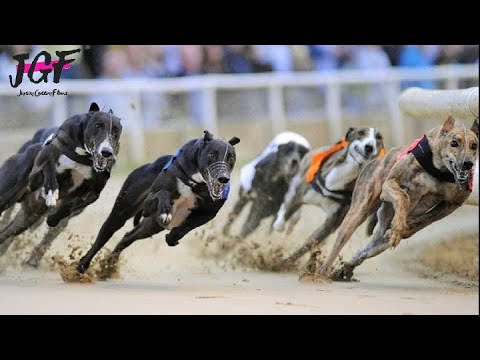

Watch this video on YouTube
The optimal age for training puppies of sports lines is 2-3 months. Such kids are not taken to treadmills, but at home they are forced to show interest and chase after a hare skin tied to a rope. Start running for a mechanical bait should be from short distances (up to 100 m), gradually increasing the distance. Dogs are good at honing the speed and technique of jogging on a leash behind a bicycle.
The usual distance of sprint races in which Greyhounds participate is 300-350 m. For English Greyhounds, this is a normal load, but before the competition, the animal is entitled to a couple of days of rest, and after it – a bowl of clean water. Overloads for a Greyhound are no less harmful than physical inactivity, so he has nothing to do at the cinema track for up to a year. In addition, only experienced, trained individuals who have been engaged in coursing for more than a season can master several races a day. For beginners, such records are not within their power. Of course, a young dog can try and give everything beyond its capabilities, but such attempts will not lead to anything good, except for the disability of the animal.
Practice shows that it is much easier to train a professional sprinter from a Greyhound than to teach him to start boxing. Once in a locked room, young individuals are frightened and behave stiffly, so at first it is better to leave both dampers open. Keeping a dog in a box for a long time is also not worth it: after sitting in a cramped “box”, it may lose interest in the pursuit and hesitate at the start. And one more thing: young playful dogs at training races do not pursue a hare, but their rivals, trying to tease them and bite them. If you notice unusual behavior for a runner behind a Greyhound, work with it separately from other dogs for the first weeks, and put a muzzle on the animal before going on the track. You do not want your ward to be disqualified for aggression at the first serious “race”?
Greyhound hunting
The first attempts to train hunting Greyhound puppies are made at 3-4 months. This is not yet a full-fledged hunt, but only the awakening of interest in game. For example, the baby is given to play with a wounded animal or sniff a bunch of feathers. You can introduce a puppy to the team of adult dogs and take it out into the field in a pack. The kid will imitate the behavior of adults, adopting the experience of older greyhounds. By the year the Greyhound is already able to catch a hare, but is not always able to bring it to the owner. The deficiency is cured by the accumulation of hunting experience: the more often the dog is allowed to ruffle the skin of the game, the faster it will learn to handle it.
An important point: immediately after the hunt, the Greyhound should not be fed with raw hare giblets or cut off pieces from the carcass. This will disorganize the pet, so in the future, instead of bringing the prey to the owner, he will try to “butcher” it himself.
They hunt with Greyhounds in flat steppe terrain and in the fields. Forest, groves, rocky ridges are potentially dangerous places for the breed. Developing a breakneck speed at the start, the Greyhound cannot maneuver between stones and trees and invariably encounters obstacles. Such “tests” end deplorably for the dog – the animal receives injuries incompatible with life, or remains crippled.
Maintenance and care
The Greyhound is a breed that prefers shade in summer and warm in winter. Ideally, it is better to keep it in heated rooms. Inveterate greyhounds with packs of dogs will have to attend to the construction of insulated booths, as well as heated aviaries and high floors, since it is unrealistic to place several pets in one house. By the way, the maintenance of Greyhounds in city apartments also takes place, since they are not demanding on space and will not get in the way.
As for physical activity, they are necessary for the grays insofar as. Take your pet for a walk twice a day, let him run for a bike – for an adult Greyhound, such a charge is more than enough. City dogs are not let off the leash for walks: English greyhounds have no fear of vehicles, and for negligent owners, they often end up under the wheels of cars. The Greyhound must spend at least 1-2 hours outside every day, and in good weather it is not a sin to increase the duration of the “excursion”, but to reduce it in cold weather. On rainy and frosty days, the dog’s body should be protected with a waterproof blanket or insulated overalls. This, of course, restricts movement, but it will protect the body from hypothermia.
Hygiene
Greyhound hair care is limited to buying a rubber mitten and combing out dead hairs from the dog’s body with it. It is necessary to arrange “bath days” only if the pet is really dirty. But since English greyhounds are innate neat, you will rarely have to drag them to the bathroom. But you need to carefully monitor the claws. Firstly, because the regrown plate prevents Greyhounds from running, which is fraught with injuries. And secondly, in puppies whose owners neglect the “pedicure” procedure, their paws become deformed, becoming more flattened and loose, so the best option is to cut their claws twice a week, polishing the cut with a nail file.
Obligatory for Greyhounds systematic brushing of teeth and ears. In the first case, it is better to arm yourself with a dog toothbrush and veterinary paste (baking soda is a cheaper alternative). Secondly – veterinary lotion and cotton pads. Greyhound eye care is to prevent their souring, for which chamomile infusion and a soft, lint-free cloth are useful. The paws of apartment warmers are subject to a thorough inspection and washing after each walk, and cracks and wounds on them should be wiped with an antiseptic. Do not forget about the treatment of ectoparasites, which is especially important for hunting lines: chasing hares through autumn and spring meadows, picking up a tick for a greyhound is a matter of minutes.
Feeding
Greyhounds do not have problems with appetite, they do not dig in a bowl, fish out a piece of a tastier one, so the standard “dog menu” for the breed will be very useful. The bet, as usual, is on lean meat. Sinuous, windy, smelly – English greyhounds willingly absorb any substandard. Two additional, albeit lower-calorie meat alternatives are boneless sea fish and offal. As for the game caught by the Greyhound, it is better not to give it to the pet without veterinary control. The same roe deer can be a carrier of various pathogens and parasites, and eating its meat will make it a patient of the veterinary clinic.
An obligatory product in the diet of a tiny Greyhound is calcined cottage cheese, which, as the puppy grows up, is replaced by low-fat fermented baked milk and kefir. Greyhound eggs are best given without protein, which is not digestible, and mixed with any milk. To strengthen the teeth, periodically buy beef bones for your dog. Hercules, rice, buckwheat porridge are good supplements if their share in a serving does not exceed 20%.
Any fruits and vegetables of the middle band are a source of vitamins and minerals, but it is better to give them raw, grated and seasoned with vegetable oil or sour cream to enhance the taste. If the dog refuses vegan salads, vegetables can be boiled and mixed with animal protein, for example, to sculpt meat and vegetable meatballs. Some breeders successfully transfer English greyhounds to industrial feeds, which is not without meaning: saving time + no need to spend money on vitamin and mineral complexes. Many nurseries even practice mixed feeding, although the method has its opponents.
Greyhound health and disease
Typical greyhound ailments are age-related arthritis, deafness (mostly in whites), hypothyroidism, eye disease, and allergies. In puppies over the age of 3 months, neuropathy is sometimes diagnosed: the first symptom is a wobbly gait. The disease is not treated, so its logical conclusion for the pet will be death.
How to choose a puppy
The principles of choosing a Greyhound puppy are the same as when buying any greyhound. Start by looking for a trusted cattery that has managed to build up a client base. If this is the first acquaintance with the breed, invite a specialist dog handler to inspect the litter, who will help you choose the most successful puppy. And of course, always be interested in the sporting and hunting achievements of the producers – the genetic inheritance of parental talents takes place in most young Greyhounds.
- Decide what type of English Greyhound you are looking for. For example, it is better to watch show-producers at exhibitions, for racing greyhounds – at movie screens, and for representatives of the working (hunting) line – in the field.
- Greyhound lines also differ in size. The largest dogs are show class, the smallest are hunting dogs.
- If you have already chosen your favorite at an exhibition or race and are ready to take a puppy from him, do not be too lazy to chat with the breeder and his ward in an informal setting. It is possible that the behavior of the animal at home will be completely different.
Greyhound price
The most expensive Greyhound is the Show Greyhound: from 1000$ and more. A baby from a couple of famous runners will cost an order of magnitude cheaper. Well, the most financially economical option is the hunting type: on average – 200$ per puppy. There are enough ads on the Internet for the sale of adults without documents – from 100$.






